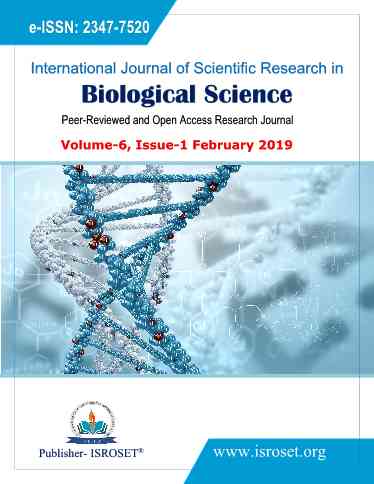Application of Immobilized Glucose Oxidase in Iron Oxide Nanoparticles in Cotton Bleaching – An Ecofriendly Approach and Greener Alternative
Keywords:
Bleaching, Glucose oxidase, Iron oxide nanoparticles, Whiteness index, RecyclabilityAbstract
Cotton, a natural textile fiber that naturally exists with impurities and yellowish color until bleaching that imparts whiteness to the fabrics. In this current research, iron oxide nanoparticles were synthesized and immobilized with microbially produced glucose oxidase which visualized by scanning electron microscope showed 62 and 112 nm respectively. Conventional and bio-bleaching of desized fabrics was done efficiently. Weight loss and water absorbency results of bio-bleached fabrics had shown higher effect than conventional whereas vice-versa in tensile strength. To ensure the quality of bleaching, whiteness index was performed and showed 65.21, 67.14 and 69.12 that corresponds for conventional and bio-bleached fabrics. Recyclability of immobilized glucose oxidase enzyme was showed better usage for 2 cycles which were enclosed by the comparison of whiteness index. Hence, we conclude that immobilized enzymatic bleaching showed significance which lacks in control and free enzyme treated fabrics.
References
S. Madhav, A.Ahamad, P. Singh, PK. Mishra. A review of textile industry: Wet processing, environmental impacts, and effluent treatment methods. Environmental Quality Management. Vol 27, Issue 3, pp:31-41, 2018
LS. Meyer-Stork. Enzymatic Finishing of Textiles. Int. Journal of Science and Research, Vol 5, Issue 5, pp.674-677, 2016.
S. Eyupoglu , N. Merdan. Eco-friendly Production Methods in Textile Wet Processes. In Sustainable Innovations in Textile Chemical Processes, pp. 31 – 65, 2018
A. Aouni, C. Fersi, B. Cuartas-Uribe, A. Bes-Pía, MI. Alcaina-Miranda, M. Dhahbi. Reactive dyes rejection and textile effluent treatment study using ultrafiltration and nanofiltration processes. Desalination. Vol 1, Issue 297, pp. 87-96, 2012.
A. Cavaco-Paulo, G. Gubitz, editors. Textile processing with enzymes. Elsevier; 2003.
A. Madhu, JN. Chakraborty. Developments in application of enzymes for textile processing. Journal of cleaner production. Vol 1, Issue 145, pp.114-33, 2017.
G. Cotin, C. Kiefer, F. Perton, D. Ihiawakrim, C. Blanco-Andujar, S. Moldovan, C. Lefevre, O. Ersen, B. Pichon, D. Mertz, S. Bégin-Colin. Unravelling the Thermal Decomposition Parameters for The Synthesis of Anisotropic Iron Oxide Nanoparticles. Nanomaterials. Vol 8, Issue 11, pp.881, 2018.
PE. Feuser, AC. Fernandes, M. Nele, A. da Cas Viegas, E. Ricci-Junior, AC. Tedesco, C. Sayer, PH. de Araújo. Simultaneous encapsulation of magnetic nanoparticles and zinc phthalocyanine in poly (methyl methacrylate) nanoparticles by miniemulsion polymerization and in vitro studies. Colloids and Surfaces B: Biointerfaces. Issue 135, pp. 357-64, 2015
S. Abdeen, RR. Isaac, S. Geo, S. Sornalekshmi, A. Rose, PK. Praseetha. Evaluation of Antimicrobial Activity of Biosynthesized Iron and Silver Nanoparticles Using the Fungi Fusarium Oxysporum and Actinomycetes sp. on Human Pathogens. Nano Biomedicine & Eng. Vol 5, Issue 1,2013.
S. Aber, E. Mahmoudikia, A. Karimi, F. Mahdizadeh. Immobilization of glucose oxidase on Fe 3 O 4 magnetic nanoparticles and its application in the removal of acid yellow 12. Water, Air, & Soil Pollution, Vol 227, Issue 3, pp. 93. 2016
EM. Rajesh, K. Shamili, R. Rajendran, M. Elango, SR. Shankar. Superparamagnetic nanoparticles of iron oxide: synthesis and characterization. Advanced Science, Engineering and Medicine. Vol 6, Issue 3, pp.268-72, 2014..
T. Tzanov, M. Calafell, GM. Guebitz, A. Cavaco-Paulo. Bio-preparation of cotton fabrics. Enzyme and Microbial Technology. Vol 29, Issue 6-7, pp.357-62, 2001..
SA. Mohamed, MH. Al-Harbi, YQ. Almulaiky, IH. Ibrahim, RM. El-Shishtawy. Immobilization of horseradish peroxidase on Fe3O4 magnetic nanoparticles. Electronic Journal of Biotechnology. Vol 27, pp. 84-90. 2017
A. Hebeish, S. Farag, S. Sharaf, TI. Shaheen,. Development of cellulose nanowhisker-polyacrylamide copolymer as a highly functional precursor in the synthesis of nanometal particles for conductive textiles. Cellulose, Vol 21, Issue 4, pp. 3055-3071, 2014.
ER. Kenawy, EA. Kamoun, MS. Eldin, MA. El-Meligy. Physically crosslinked poly (vinyl alcohol)-hydroxyethyl starch blend hydrogel membranes: Synthesis and characterization for biomedical applications. Arabian Journal of Chemistry. Vol 7, Issue 3, pp.372-80, 2014.
R. Ahmad, M. Sardar. Enzyme immobilization: an overview on nanoparticles as immobilization matrix. Biochemistry and Analytical Biochemistry. Vol 4, Issue 2, pp.1, 2015.
A. Lassoued, B. Dkhil, A. Gadri, S. Ammar. Control of the shape and size of iron oxide (α-Fe2O3) nanoparticles synthesized through the chemical precipitation method. Results in physics. Vol 7, pp.3007-15, 2017.
O. Ardon, Z. Kerem, Y. Hadar. Enhancement of laccase activity in liquid cultures of the ligninolytic fungus Pleurotus ostreatus by cotton stalk extract. Journal of Biotechnology. Vol 51, Issue 3, pp.201-07, 1996.
A. Farooq, S. Ali, N. Abbas, GA. Fatima, MA. Ashraf. Comparative performance evaluation of conventional bleaching and enzymatic bleaching with glucose oxidase on knitted cotton fabric. Journal of cleaner production. Vol 42, pp. 167-71, 2013.
A. Cavaco-Paulo, L. Almeida, D. Bishop. Effects of agitation and endoglucanase pretreatment on the hydrolysis of cotton fabrics by a total cellulase. Textile Research Journal. Vol 66, Issue 5, pp. 287-94, 1996.
AA. Ramadan. Characterization of biobleaching of cotton/linen fabrics. Journal of Textile and Apparel, Technology and Management. Vol 6, Issue 1, 2008.
AI. Wasif, YM. Indi. Combined scouring-bleaching of cotton using potassium persulphate. 2010.
R. Anusuya, K. Srimathi, "Bacterial Production of Protease-A Preliminary Study", International Journal of Scientific Research in Biological Sciences, Vol.5, Issue.6, pp.163-169, 2018
Downloads
Published
How to Cite
Issue
Section
License

This work is licensed under a Creative Commons Attribution 4.0 International License.
Authors contributing to this journal agree to publish their articles under the Creative Commons Attribution 4.0 International License, allowing third parties to share their work (copy, distribute, transmit) and to adapt it, under the condition that the authors are given credit and that in the event of reuse or distribution, the terms of this license are made clear.







